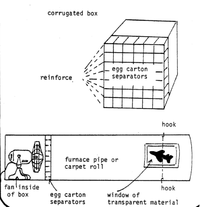from Come Fly With Me – Exploring Science through aviation and aerospace concepts.
SUBJECT: Science
GRADE: 7,8,9
GROUP SIZE: Small
TIME: 2 or 3 60 minute periods
TYPE OF ACTIVITY: Construction and Student Investigation
TEACHING STRATEGY: Expository Guided Discovery
CONCEPTS: Scale Model Control Surface
SKILLS: Modeling, Experimenting Interpreting Data
Objectives: To demonstrate the effects of the manipulation of flight control surfaces of a plane on its flight characteristics; to demonstrate on a small scale how scientists test those characteristics on larger planes and rockets before they fly; to realize some of the benefits which may occur from scientific “modeling”.
Materials: Piece of furnace pipe or carpet roll about 1.3 meters long; piece of transparency film for the tunnel window; separations from an egg carton (available at the grocery, some bakeries, a restaurant, or you may build a similar one from strips of light cardboard); heavy cardboard or a box the same size as the egg carton divider; book tape or duct tape; an electric fan; 2 small hooks of the type used to hang cups; metal shears or a saber saw depending on the material your tunnel is to be constructed of.
Teacher Background Information:
The tunnel~like chambers through which air is passed at different velocities are used to study airflow over an object like a plane or rocket. The automobile industry also uses wind tunnels in their research to produce more fuel efficient cars. Some of the wind tunnels in the United States are large enough to hold full size planes or rockets for testing. One such tunnel is at the Langley, NASA Research facility in Virginia. A supersonic tunnel is at the NASA Lewis Research Center in Cleveland, Ohio. A model of the shuttle was tested and perfected in this tunnel before it was produced.
There are any number of small wind tunnels which you or a small group of students can prepare. The one suggested here is a relatively simple one requiring a minimum of exotic materials. If you would like to prepare a more sophisticated model, refer to additional sources such as science teacher resource manuals or online resources.
Procedure:
Open the carton separators and strengthen the corners with tape. Open a box at both ends and place the separator grid into the box. They should fit snugly. Cut a window near one end of the roll or pipe and cover it with the clear film or acetate. Tape the film down using the book binder’s tape. Fasten the hooks on opposite sides of the tube so that a plane hanging from the top one will be positioned in front of the window. (Refer to the illustration). Set the egg carton separations flush against the pipe or tube and place a fan in the box holding the separators. The separators will straighten the swirling air from the fan.
1. Have the students prepare a suspension system for the model airplane to be tested.
- a. Use a strong rubber band of the type you find on Civil Air Patrol, FAA model airplanes reprint GA-20-30. Cut the band in one place.
- b. String two note book paper reinforcement rings on the rubber band and glue them together.
- c. Tie the cut ends of the rubber band back together again
- d. To attach the model to be tested, place a pin through the model and the ring near the center of gravity of the model.
- e. Attach a similar rubber band to the lower hook as well.
2. Have the students start by building paper airplane models and testing the effects of manipulation of the control surfaces of the model. They should discover that to climb, elevators are up; to dive, elevators are down; to turn right, the rudder is right, the right aileron is up, the left aileron is down; to turn left, the rudder is left, the left aileron is up, the right aileron is down.
3. Have the students investigate the effects of changing the center of gravity on the stability of the plane.
Extensions: Have the students prepare and test model rockets, before actual flight, in the tunnel and compare the actual flight results with their data collected from the tests after launch. Have them find out more about wind tunnel testing of automobiles and investigate spin offs from the science of aerodynamics to the auto industry.

